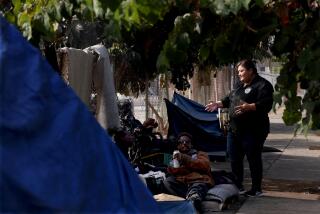EARTHQUAKE: THE LONG ROAD BACK : Anti-Crime Groups to Include Disaster Readiness
- Share via
Impressed by the way some San Fernando Valley Neighborhood Watch groups coped with the Northridge earthquake, police and city officials want to turn the local anti-crime groups into full-fledged emergency preparedness teams for the next disaster.
One of the lessons of the quake was that the suburban neighbors who had banded together under police supervision in the Neighborhood Watch groups were much better at dealing with the disaster than the rest of the city, police and city officials said.
Some checked for gas leaks while others knew where to find the elderly and children that might need help. While some scurried about sizing up their neighborhood’s problems, others relayed that information to police and city officials through assigned liaison officers.
And because they knew each other, Neighborhood Watch members shared their pantries and homes with the less fortunate among them.
Now, in the wake of the deadly quake--and in preparation for other calamities--police have quietly begun transforming the Neighborhood Watch program in the West San Fernando Valley from a vehicle for monitoring crime into a full-fledged, disaster response system, encouraging residents to be as self-reliant as possible.
The next step, they said Monday, will be to try to expand the program citywide. That way, when police and firefighters are busy handling the most critical problems, many residents will be capable of fending for themselves.
“The time is right, based on our recent experience,” said West Valley Police Capt. Val Paniccia, who has ordered the expansion of the Neighborhood Watch groups in his division. “The real key in any major disaster is being able to survive the first few days. And as a group you can survive a lot longer and better.”
The police, Los Angeles City Councilwoman Laura Chick and the city Fire Department have pledged to work jointly to get West Valley neighbors together, and to train them in first aid and other emergency response techniques.
“We can turn a disaster into an opportunity to do things better,” said Chick, whose office came up with the idea about the same time police did. “Now this is an ASAP priority thing.”
Under the Neighborhood Watch program, residents meet regularly on a block-by-block basis to discuss crime issues, and keep watch for criminal activity. Block captains keep track of what happens on their streets, reporting to police community representatives--citizens who stay in contact with authorities and the City Council member’s office.
But in the hours after the Jan. 17 jolt, something unexpected happened on those West Valley streets organized under the Neighborhood Watch system. Even before the sun rose, residents met with neighbors and canvassed their areas, checking to see if everyone was OK, helping those who were not and locating gas leaks and other hazards.
“Oh God, did it ever work--it was wonderful,” said Marilyn Robinson, 49, a Neighborhood Watch leader for the Bassett Street group in Quimby Park. “You know names, you know who to look for. We shared our water. We made coffee. We even met neighbors who just moved in.”
The Neighborhood Watch apparatus enabled the 274 members of the Quimby Park group to do much more than share food. Within a day, they had compiled a list of residents who wanted city building and safety inspectors to check their homes for damage, and Robinson forwarded it to her field representative in Chick’s office. “We had them out within two days,” Robinson said.
Through her block captains, Robinson also was able to spread important news, such as that a water tank had been brought into the parking lot at Canoga Park High School. Watch members patrolled the area day and night, looking for looters and other signs of trouble.
Now, groups such as Robinson’s are anticipating expanding into disaster response teams. At a Feb. 2 meeting at West Valley police headquarters, about 50 Neighborhood Watch leaders met with police, and had their pictures taken and made into identification cards. Quimby Park and the nine other Neighborhood Watch groups in the immediate area will send a representative to an emergency preparedness class scheduled to start Feb. 28.
“God forbid, in case the (phone) lines are down and we can’t get through, we would know what to do,” Robinson said. “When you have a disaster you can band together.”
*
Based on their experience in the Northridge quake, police and city officials acknowledge that many residents will be on their own in the event of another major disaster, especially during the critical first hours.
But having residents who can care for themselves and secure their neighborhoods will be important in the days and weeks after a major disaster, they said, when food and water will be scarce and lines of communication will be down.
As planned, the groups would have checklists of how to respond to each disaster--floods, earthquakes, fires--and specific tasks for each person. Residents would know where to report for duty, and central command posts could be established where people could meet and get their bearings, Paniccia said.
“They could take tallies of damage in their areas, and get better police response,” Paniccia said. “And it’s an automatic anti-looting patrol. They will know who belongs and who doesn’t.”
Paniccia said he is looking into finding ways each neighborhood can be provided with a shed containing a master list of residents, search and rescue tools, food and water, water purification systems, a comprehensive first aid kit and other important equipment.
More to Read
Sign up for Essential California
The most important California stories and recommendations in your inbox every morning.
You may occasionally receive promotional content from the Los Angeles Times.









